
Souvenir decks
A souvenir deck is a deck of playing cards created in order to serve as a souvenir for tourists or visitors. Typically such playing cards have scenes from different locations, and depict things like notable landmarks, buildings, wildlife, flora, or other unique elements about the place in question. In many cases the card backs will have an image or text that captures something of the overall locale. Each card will then have a different photo or image that occupies most of the space on the card in the area where you would normally find the main images for the court cards and pips. Indices on opposite corners that indicate the suit and value of each card ensure that it can still serve as a playable deck of cards. Effectively such a deck of playing cards serves as a miniature photo album, capturing key images of a place, so it’s an ideal product for tourists to purchase in a souvenir shop. Souvenir decks need not necessarily be about a particular country or city, but could even be created for an attraction like a Zoo or theme park, and even for a notable event. They are primarily created for the visual images on the cards, rather than for intensive use in playing card games. As a result, they tend to be made very cheaply, with thin card-stock that performs poorly for handling and shuffling. But they do make great novelty items, and achieve the purpose for which they were created, which is as an item of memorabilia. At the same time they have some practical function, and enable you to play card games while you’re on vacation if you really want to. While not strictly souvenir decks, many of the decks produced by US Game Systems Inc and Piatnik almost qualify for this category. Their novelty decks don’t come close to matching the quality of a Bicycle deck, but they are quite inexpensive, and contain many delightful images and pictures that are the center-piece of the individual cards, which are the real attraction and reason for buying these decks. ● See a range of Piatnik-produced novelty decks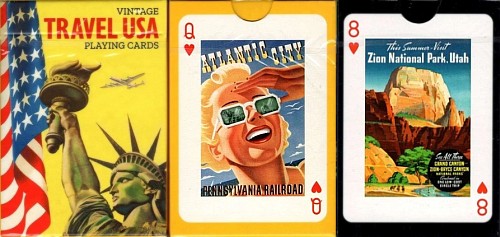
Advertising decks
It didn’t take playing card manufacturers long to realize the potential to use playing cards as a means of advertising. In a way much like souvenir cards, playing cards are ideal for companies to use to market their business or products. Advertising decks have been around for a long time, and there are some wonderful examples of 19th century decks. My favourite one is the Murphy Varnish deck, which features transformation cards, and wonderful court cards that depict and promote Murphy’s Vanish. Many advertising decks are created on a budget, since the goal is about marketing a product or a brand, rather than producing a quality deck of playing cards that will be durable or visually exceptional. But there are many famous brands that have devoted fans, that makes advertising decks featuring these companies or products immediately attractive to collectors who collect memorabilia associated with that company or product. For example, a deck of playing cards that pays homage to Coca Cola won’t only appeal to playing card enthusiasts, but will have a crossover appeal to anyone who collects Coca Cola paraphernalia. Decks that feature brands of beer and whisky are popular for similar reasons. As a result you’ll find playing cards that advertise popular alcoholic drinks like Jack Daniels, as well as famous makes of motorbikes and motor-vehicles, like Harley Davidson and Ford. ● See a range of advertising decks
Licensed decks
Closely related to the category of advertising decks are playing cards that pay tribute to popular movies, TV shows, books, music, or other icons in popular culture. These are extremely collectible, due to their immediate appeal for anyone who is a fan of the cultural icon in question. But to make them, creators of playing cards often need to pay a licensing fee to the owner of the “brand” or intellectual property that appears on the cards, and hence the unofficial designation “licensed decks”. They could equally be considered “fan decks”. Examples of these include playing cards that pay tribute to films like Jaws, Star Wars, and Lord of the Rings; TV shows like Saturday Night Live; comic strips like Peanuts, Spider Man, and Marvel’s Avengers; and characters like Mickey Mouse and Donald Duck from Disney. Some of these are created as pure novelty decks, and the artwork is such that they could never even be used for card games. ● See a range of licensed decks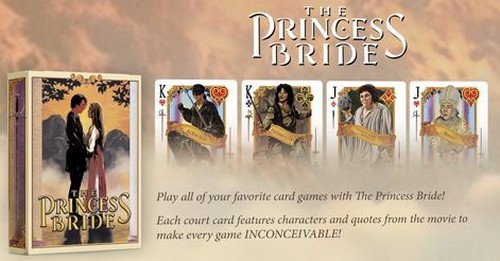
Cardistry decks
Card flourishing is not something new, and magicians have long incorporated flourishes within their acts. However in the last decade cardistry has really developed an independent existence alongside and separate from card magic, and is rapidly cementing its legitimacy as an art-form in its own right. Cardistry can loosely be described as the performance art of card juggling, and typically involves someone doing visually impressive cuts, twirls, spins, and more with a deck of cards. Social media and the ability to share videos online have really helped cardistry grow rapidly, and it’s especially being embraced by a younger generation. But cardistry has also spawned a new type of deck, created especially for cardistry. Given that it is all about visuals, card flourishing will benefit the most when the deck used is colourful and has striking patterns that enhance the visual aesthetics of the flourishes themselves. This led to the creation of decks that were optimized and designed specifically for the purposes cardistry. Singapore-based cardistry group The Virts was at the forefront of this development, with the creation of their Virtuoso deck, which became a popular and highly sought after series. The success of the cardistry movement meant that playing cards did not have to be functional for playing games or card magic, and that there was a ready market prepared to drop money to buy decks that were simply about visual aesthetics. Some cardistry decks can serve a dual purpose of being used for games or magic, but the primary goal of a cardistry deck is the visual appeal. Typically a cardistry deck demands the very highest standard in terms of quality and performance, and features a design and pattern that looks great when the cards are being handled. Some cardistry decks abandon pips and indices altogether, and there are even cardistry decks where every card is identical on both the front and back. ● See a range of cardistry decks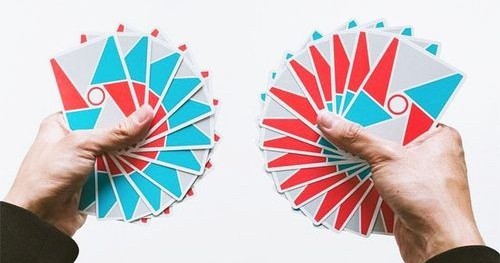
Throwing decks
Also deserving separate mention are decks intended specifically for card throwing. Card throwing has received significant media attention as a result of the impressive feats of Rick Smith Jr, who has been featured in some remarkable viral videos from Dude Perfect, and who holds several world records for throwing playing cards the fastest and furthest. While any deck can be used for card throwing, there are custom decks that have been created specifically with the idea of enhancing this unique use of playing cards. In some cases, the intended goal of a dedicated throwing deck is all about creating a visual effect when the cards are rotating and in motion. Rick Smith Jr’s Falcon Throwing Cards have been designed with exactly this kind of aesthetic in mind, and even incorporate a special marking system in the artwork to help measure how deep the cards go when thrown into objects like foam or fruit. Besides this, they are a relatively standard deck of playing cards in terms of the quality and feel, although a thicker than normal card-stock has been adopted in view of their intended use. Some of the Banshee decks also include a measuring system on the card faces, but also have bevelled edges geared to maximize their ability to penetrate objects. Perhaps best of all, they incorporate custom holes uniquely designed to produce a sonic scream when the cards whiz through the air. ● See a range of throwing decks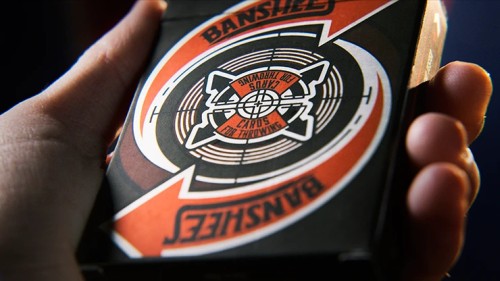
Animation decks
In a unique category of their own are decks designed specifically to be animated. Typically this involves using a flip-book animation technique. The method used to do this is sometimes described as “taking a deck to the movies”. The idea is that you use your thumb to flip through all the cards rapidly, thereby creating the illusion of a moving image. The Bicycle Cinema Playing Cards are one example of such an animation deck. It has cards that look like a film strip, with a classic yellowed finish for a nostalgic and old time look. When flipping through the cards, an animation feature creates the 3-2-1 count-down that old movies would have, while the film strip sides also appear to move vertically. The Mechanic deck uses a similar technique to create the impression of moving cogs, while the Optricks deck is designed to create a mesmerizing hypnotic effect with moving lines. Also belonging in this category are the Clockwork decks. Those interested in card magic will also love Dan Harlan’s Card Toon deck, which is a gaff deck featuring an animated stick man, and which uses this principle to reveal a selected card in an amusing manner. ● See a range of animation decks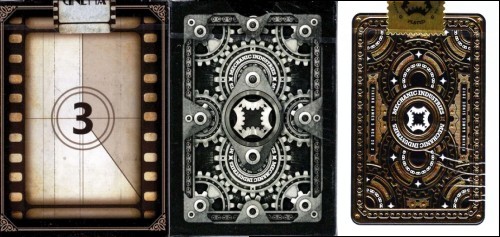
Limited edition decks
Not every deck of playing cards is intended to be used for playing card games, or for card magic or cardistry. There many collectors who enjoy the hobby of collecting out of sheer love for the variety and novelty of the playing cards themselves. Particularly in the crowdfunding era, many creators have emerged and cemented themselves with a solid reputation as designers whose goal is to create highly collectible playing cards, some of which are produced in limited editions to make them even more exclusive. In some cases, these can be in high demand in the secondary market, and over time can be highly sought after by collectors. These limited edition decks often have extra touches that make them appealing to the card collector, with an individually numbered tuck seal being a key element of this. Such tuck seals will often indicate the size of the print run, and give each deck an individual number, e.g. 578/1000. Limited edition decks often have lavish tuck boxes, or have other intriguing features about them to help make them unique and interesting. They tend to be produced by well-known designers with an existing reputation of creativity and success, but even new creators will sometimes produce a limited edition version of a project, in order to appeal to the collector looking for something especially classy or unique. ● See a range of decks with numbered seals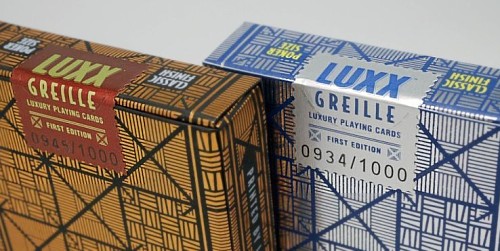
Gilded decks
Once in a while what you’re looking for is something absurdly expensive and over-the-top. There are lots of ways to add bling to a deck of playing cards, including gold foil and embossing on the tuck box, or else flashes of iridescence or UV spot printing on the cards, all delivered in an exotic looking tuck case. But perhaps there is no other feature in a deck of playing cards that screams “luxury” as much as gilded edges. Traditionally, gilding was accomplished by hand, with master craftsman literally painting the edges of the cards with gold or silver paint. Sometimes this manual process is still used to create a gilded deck, although technology has opened up other ways of accomplishing this. But there’s no doubt that the end result looks absolutely fantastic! Gold and silver are the two most popular colours of choice for gilding, but modern gilding methods allow for a range of different colours to be used, so you’ll find gilded decks of all styles and colours. Often a gilded deck will arrive with the cards still stuck together, because the gilding is still intact. That’s perfectly normal, and you need to carefully separate the cards individually before using them. Regular use will cause gilding to wear, so you can’t expect a gilded deck to retain its shiny look forever. However, even after lots of shuffling and handling, you will still be able to recognize that a deck was gilded, and distinguish it from a non-gilded deck. Primarily intended for collectors, a gilded deck certainly adds an impressive amount of bling to your deck, but naturally this also means that it comes at a much higher cost. ● See a range of gilded decks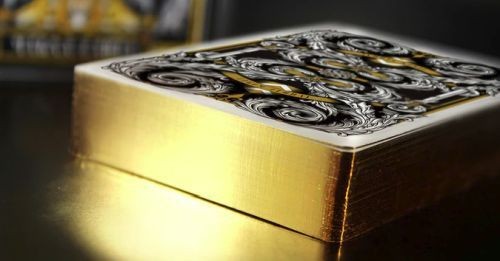
Tarot decks
Tarot decks deserve a separate category, and are often misunderstood. To begin with, the key difference that distinguishes a Tarot deck from a standard deck of playing cards is that it has 26 extra cards. Each suit has four court cards instead of three, and there are also 22 additional cards, usually described as Major Arcana. These extra cards are the simple explanation that lies behind the emergence of the Tarot deck, since it simply came about as a way of increasing the complexity of card games by including extra trump cards. The origin of the Tarot deck is often the subject of controversy, with some people believing that Tarot cards had roots in the occult and that they were linked to ancient secret societies that disseminated esoteric knowledge. According to this view, Tarot decks were the original form of playing cards, from which the standard deck developed. But after the publication of The Game of Tarot: From Ferrara to Salt Lake City (1980) by respected academic Michael Dummett, there is a growing consensus that there is no evidence of Tarot decks being used for fortune-telling and the occult until the 18th century, while standard playing cards already appeared in Europe in the 14th century. The “Major Arcana” was first added to the traditional deck already in the 15th century, long before any occultic use, and it served as a fixed trump suit in trick taking games. That’s how Tarot decks were used for several centuries, until they cartomancers became infatuated with them around the 18th century, causing them to develop a life of their own for fortune telling, and taking their artwork in a new direction. Regardless of the history, the number of cards in a Tarot deck is quite firmly established, and today it is clearly distinguished from a regular deck. It typically comes with highly attractive and visual artwork, often reflecting occultic themes linked to fortune-telling. Regardless of your position about their history, development, and function, it’s not hard to see how Tarot cards are very collectible, in view of their distinct characteristics and visual appeal. ● See a range of Tarot decks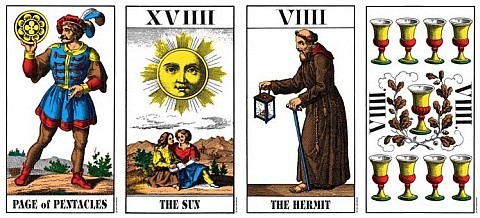
Oracle decks
Unlike traditional decks, and Tarot decks, Oracle cards don’t have a set number of cards or fixed structure. A deck of Oracle cards could consist of anything from 12 to 100 cards, for example. There are no real rules about what cards a deck might contain, other than that the cards are spiritual in nature. Besides that, an oracle deck can be anything that its creator wants to make it consist of, both in terms of the number of cards, and which ones. The Lenormand decks are good example of this kind of fortune-telling deck. While the Tarot deck can be used for card games, Oracle cards are strictly used for fortune-telling. The expression “fortune-telling cards” need not refer exclusively to Oracle decks, however. The practice of fortune telling using a deck of cards is referred to as cartomancy, and the most popular deck used by cartomancers today is the Tarot deck. Sometimes even a traditional deck of 52 playing cards can be used for fortune telling and divination. There are also decks of standard cards that are particularly created with a view to cartomancy, such as the Ye Witches Fortune Cards (1896), Kadar Fortune Playing Cards, and Cartomancer Fortune deck. ● See a range of Oracle decks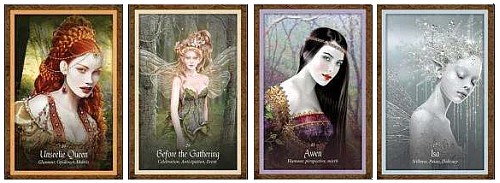
About Shuffled Ink
Shuffled Ink is a multigenerational family business that specializes in printing custom playing cards, tarot & flash cards, custom card games, packaging and more for businesses and individuals worldwide.
To receive complimentary samples of our card products, either follow this link or please include your delivery address and phone number on your custom quote request form.